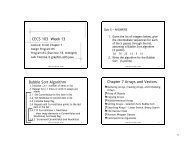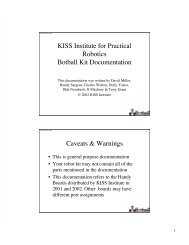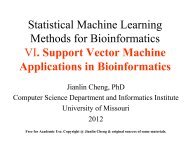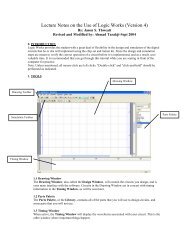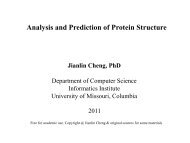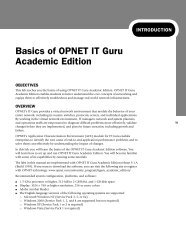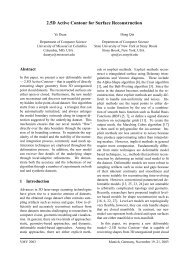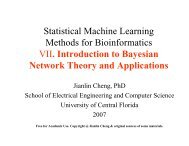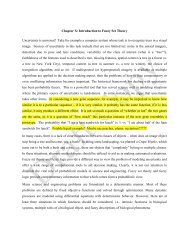Machine Learning Methods for Protein Structure ... - ResearchGate
Machine Learning Methods for Protein Structure ... - ResearchGate
Machine Learning Methods for Protein Structure ... - ResearchGate
Create successful ePaper yourself
Turn your PDF publications into a flip-book with our unique Google optimized e-Paper software.
42 IEEE REVIEWS IN BIOMEDICAL ENGINEERING, VOL. 1, 2008<br />
Fig. 2. One-dimensional protein structure prediction. Three-dimensional example of 1-D protein structure prediction where the input primary sequence of amino<br />
acid is “translated” into an output sequence of secondary structure assignments <strong>for</strong> each amino acid (C =coil; H=helix; E=beta-strand[extended sheet)].<br />
provides invaluable in<strong>for</strong>mation to help further understand how<br />
a protein chain folds into its unique 3-D structure, how chains<br />
interact in quaternary complexes, and how to predict structures<br />
from primary sequences [16].<br />
Since the pioneering experiments [1], [2], [5], [6], [17]<br />
showing that a protein’s structure is dictated by its sequence,<br />
predicting protein structure from its sequence has become one<br />
of the most fundamental problems in structural biology (Fig. 1).<br />
This is not only a fundamental theoretical challenge but also<br />
a practical one due to the discrepancy between the number<br />
of protein sequences and solved structures. In the genomic<br />
era, with the application of high-throughput DNA and protein<br />
sequencing technologies, the number of protein sequences<br />
has increased exponentially, at a pace that exceeds the pace at<br />
which protein structures are solved experimentally. Currently,<br />
only about 1.5% of protein sequences (about 40 000 out of<br />
2.5 million known sequences available) have solved structures<br />
and the gap between proteins with known structures and with<br />
unknown structures is still increasing.<br />
In spite of progress in robotics and other areas, experimental<br />
determination of a protein structure can still be expensive, labor<br />
intensive, time consuming, and not always possible. Some of the<br />
hardest challenges involve large quaternary complexes or particular<br />
classes of proteins, such as membrane proteins which are<br />
associated with a complex lipid bilayer environment. These proteins<br />
are particularly difficult to crystallize. Although membrane<br />
proteins are extremely important <strong>for</strong> biology and medicine, only<br />
a few dozen membrane protein structures are available in the<br />
PDB. Thus, in the remainder of this paper we focus almost exclusively<br />
on globular, nonmembrane proteins that are typically<br />
found in the cytoplasm or the nucleus of the cell, or that are secreted<br />
by the cell.<br />
<strong>Protein</strong> structure prediction software is becoming an important<br />
proteomic tool <strong>for</strong> understanding phenomena in modern<br />
molecular and cell biology [18] and has important applications<br />
in biotechnology and medicine [19]. Here, we look at protein<br />
structure prediction at multiple levels, from 1-D to 4-D [20]<br />
and focus on the contributions made by machine learning approaches<br />
[21]. The 1-D prediction focuses on predicting structural<br />
features such as secondary structure [22]–[25] and relative<br />
solvent accessibility [26], [27] of each residue along the<br />
primary 1-D protein sequence (Fig. 2). The 2-D prediction focuses<br />
on predicting the spatial relationship between residues,<br />
such as distance and contact map prediction [28], [29] and disulfide<br />
bond prediction [30]–[33] (Fig. 3). One essential characteristic<br />
of these 2-D representations is that they are independent of<br />
any rotations and translations of the protein, there<strong>for</strong>e independent<br />
of any frame of coordinates, which appear only in the 3-D<br />
level. The 3-D prediction focuses on predicting the coordinates<br />
<strong>for</strong> all the residues or atoms of a protein in a 3-D space. Although<br />
the ultimate goal is to predict 3-D structure, 1-D and 2-D predictions<br />
are often used as input <strong>for</strong> 3-D coordinate predictors; furthermore,<br />
1-D and 2-D predictions are also of intrinsic interest<br />
(Fig. 4). Finally, 4-D prediction focuses on the prediction of the<br />
structure of protein complexes comprised of several folded protein<br />
chains (Fig. 5).<br />
The 1-D, 2-D, and 3-D protein structure prediction methods<br />
are routinely evaluated in the Critical Assessment of Techniques<br />
<strong>for</strong> the <strong>Protein</strong> <strong>Structure</strong> Prediction (CASP) [34] experiment—a<br />
community-wide experiment <strong>for</strong> blind protein structure prediction<br />
held every two years since 1994. The 4-D prediction<br />
methods are currently evaluated in the Critical Assessment of<br />
Techniques <strong>for</strong> <strong>Protein</strong> Interaction (CAPRI) [35]—a community-wide<br />
experiment <strong>for</strong> protein interaction. The assessment<br />
results are published in the supplemental issues of the journal<br />
<strong>Protein</strong>s.<br />
To date, the most successful structure prediction methods<br />
have been knowledge based. Knowledge-based methods involve<br />
learning or extracting knowledge from existing solved<br />
protein structures and generalizing the gained knowledge to<br />
new proteins whose structures are unknown. <strong>Machine</strong> learning<br />
methods [21] that can automatically extract knowledge from<br />
the PDB are an important class of tools and have been widely<br />
used in all aspects of protein structure prediction. Here, we<br />
review the development and application of machine learning<br />
methods in 1-D, 2-D, 3-D, and 4-D structure prediction.<br />
We focus primarily on unsupervised clustering methods and<br />
three supervised machine learning methods including hidden<br />
Markov models (HMMs) [21], [36], [37], neural networks [21],<br />
[38], and support vector machines [39] <strong>for</strong> 1-D, 2-D, 3-D, and<br />
4-D structure prediction problems. We emphasize their applications<br />
to the problem of predicting the structure of globular proteins,<br />
which are the most abundant proteins—roughly 75% of<br />
a typical proteome—and <strong>for</strong> which several prediction methods<br />
have been developed. We also briefly review some applications<br />
of these methods to the prediction of the structure of membrane<br />
proteins, although far less training data is available <strong>for</strong> this class<br />
of proteins.<br />
II. MACHINE LEARNING METHODS FOR 1-D<br />
STRUCTURE PREDICTION<br />
Many protein structural feature predictions are 1-D prediction<br />
problems, including, <strong>for</strong> example, secondary structure prediction,<br />
solvent accessibility prediction, disordered region predic-<br />
Authorized licensed use limited to: University of Missouri System. Downloaded on April 8, 2009 at 18:32 from IEEE Xplore. Restrictions apply.



